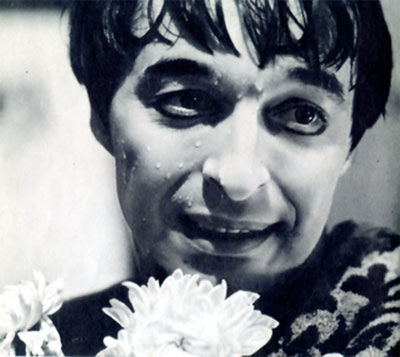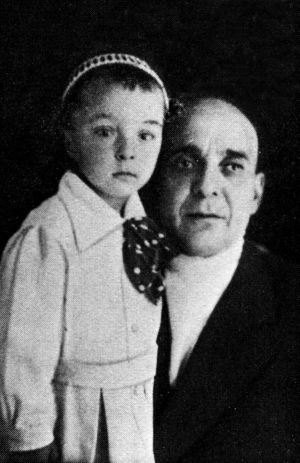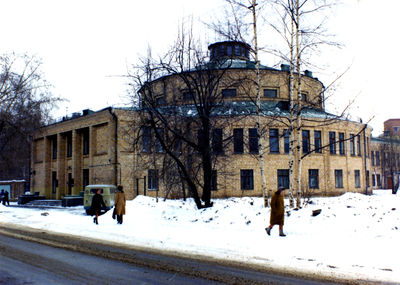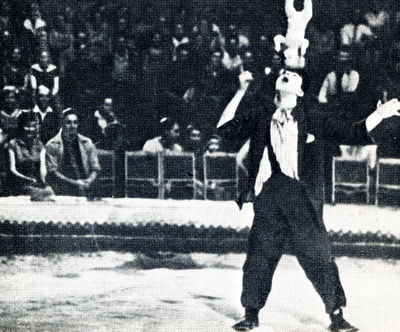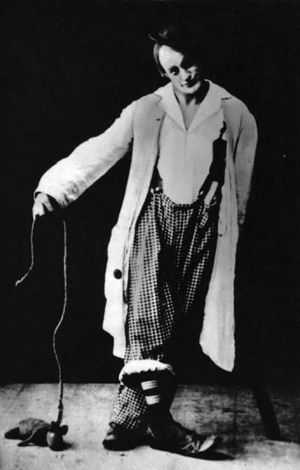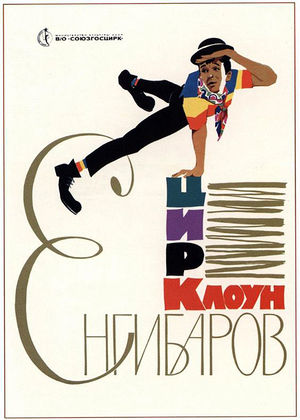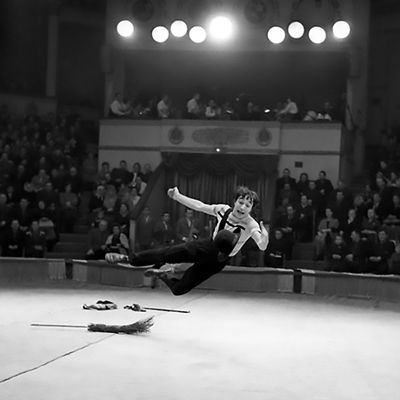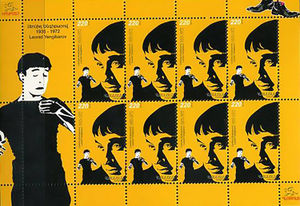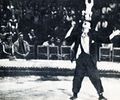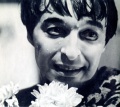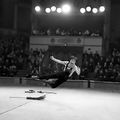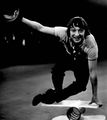Leonid Engibarov
From Circopedia
Clown
By Dominique Jando
Although he had a meteoric career that lasted only twelve years, the influence of Leonid Engibarov (1935-1972) on modern clowning has been considerable. His untimely death also propelled him into the realm of show business legends, in the rarefied atmosphere shared by prematurely disappeared young artists who helped define a generation: James Dean for the American cinema, Gérard Philippe for the French theater, Vladimir Visotskiy for Russian pop music—among others. And Leonid Engibarov for the Russian circus.
In the ring, Engibarov’s character reflected his true off-stage persona: A fiercely independent young man, mischievous, belligerent, in constant revolt against the powers that be—whether the ringmaster(American, English) The name given today to the old position of Equestrian Director, and by extension, to the presenter of the show. in the circus ring, or SoyuzGosTsirk, the central Soviet circus organization, in real life. In this, he embodied the moods of a new Soviet youth, which danced the twist, listened to the Beatles, and tried to erase three decades of Stalinist tyranny.
From The Boxing Ring To The Circus Ring
Leonid Georgievich Engibarov was born March 15, 1935 in Moscow. His father, Georgy, was Armenian. A cook, he had risen to the rank of chef and manager of the very exclusive restaurant at the Metropole Hotel—the longtime meeting place of the Soviet regime’s apparatchiks and their important foreign guests. Leonid’s mother, Antonina, was a housewife; Leonid and his mother would remain very close until the end. Leonid also had a half-brother, Mikhail, twenty years his elder, who initiated him to literature, poetry, arts and sports.As a teenager, Leonid went to boxing school, which channeled his unbounded energy and gave him intense physical training. He participated in amateur bouts and was also an enthusiastic soccer player: One of his cherished possessions was a soccer ball his half-brother had given him. This led Leonid naturally to the Moscow Sports Institute, where he began working toward a Master's Degree in Sports. But this course of study didn’t truly satisfy his artistically inclined mind and personality, and he left the Institute after only a few months.
For a short time, Leonid considered going into the movies, but his epiphany came when he saw the illustrious clown Karandash (Mikhail Rumiantsev, 1901-1983) performing at the Old Circus on Tsvetnoy Boulevard. Like sports, circus was indeed highly physical, yet it was also a creative art—and clowning could, so Leonid believed, suit at the same time his need for physical activities, his own sense of humor, and his creative mind.
A man of diminutive stature with a natural ability for comedy, Karandash had studied circus arts with the very first promotion of the K.C.I. (Circus Arts Classes) school—soon to become Moscow’s State College for Circus and Variety Arts. He had graduated in 1930 as an all-around acrobat, but chose to become a clownGeneric term for all clowns and augustes. '''Specific:''' In Europe, the elegant, whiteface character who plays the role of the straight man to the Auguste in a clown team.. As luck had it, when Engibarov considered becoming a clown himself in 1955, the College had just added a Clowning section to its curricula. So Leonid made his mind and applied for what is today widely known as the "Moscow Circus School." His athletic abilities helped him pass the college’s rigorous selection process, and he began studying circus disciplines and clowning in 1956, at age twenty-one.
Clown School
At first, Leonid was a little disoriented: Nine years of participating in competitive sports had taught him that the knowledge and use of precise techniques brought out clear results. Not so with clowning, which is of a much more intuitive nature, and whose actual study is mostly defined by trial and error. Beside, the clowning program was new, based principally upon the study of a large variety of circus skills, and theater classes including an emphasis on diction—since Russian clowns had been traditionally satirists (and sometimes, political satirists, like Anatoly Durov), who often relied on verbal humor.Several influences, both within and outside the school, would eventually help define Leonid’s unique clown persona. The first came from his deep appreciation of silent movie comedians, and notably Buster Keaton, his idol—and like him a very physical clown if any. Engibarov’s clown silhouette and appearance would be reminiscent of Keaton’s in his early shorts, or even in later movie features such as The General or Hospitality.
The second influence was Natalia Solovieva, a "pedagogue(Russian, from the French) A teacher in a Russian circus school." (teacher) and "regisseur(German, from the French: Régisseur) In Russia, the equivalent of a theatrical director in the circus." (director) at the school and granddaughter of the famous Russian historian S.M. Soloviev, who helped Leonid develop his aesthetic vision. She remembered that Engibarov was "very intellectual, with a huge sense of aesthetics," and was very interested in literature, particularly eighteenth-century Russian poetry.
The third and perhaps most important influence at the School was Nikolai Kiss, the father of the legendary acrobats (and future "pedagogues") Aleksandr and Violetta Kiss, and himself a former clown and juggler. Engibarov considered Kiss his mentor; Kiss taught him the importance of a strong acrobatic technique—which indeed he gave him—as well as the subtleties of juggling.
Engibarov had of course many other teachers (then as now, the Moscow school had a huge faculty), among whom Yury Belov, who was his "pedagogue(Russian, from the French) A teacher in a Russian circus school.-regisseur(German, from the French: Régisseur) In Russia, the equivalent of a theatrical director in the circus."—the teacher in charge of developing the concept of his act. But he had also another, if indirect, teacher in the person of Marcel Marceau. The celebrated French mime has begun his first world tour, and had visited Moscow and Leningrad. It was a time when the art of classic pantomimeA circus play, not necessarily mute, with a dramatic story-line (a regular feature in 18th and 19th century circus performances). was all but forgotten, and Marceau had been a sensation among the Russian theater community—and among the clown students at the circus school.
Pantomime was not taught in the Clown program then (it would be introduced a few years later), but students gave it an enthusiastic try nonetheless—even though it was strongly disapproved by the school’s authorities. As far as pantomimeA circus play, not necessarily mute, with a dramatic story-line (a regular feature in 18th and 19th century circus performances). went, Leonid, like his fellow students, was self-taught, but he became a passionate practitioner and advocate of that art and finally decided he would be a silent clownGeneric term for all clowns and augustes. '''Specific:''' In Europe, the elegant, whiteface character who plays the role of the straight man to the Auguste in a clown team.: "People come to the circus to see a clownGeneric term for all clowns and augustes. '''Specific:''' In Europe, the elegant, whiteface character who plays the role of the straight man to the Auguste in a clown team., not to listen to him!" he would later say to justify his choice.
Trials And Errors
Leonid Engibarov graduated in 1959, and was hired by SoyuzGosTsirk, which sent him to the circus collective of Erivan, capital of the Armenian Republic, then part of the USSR. The Armenian Circus was scheduled to appear at the Circus of Novosibirsk, in central Russia, where Engibarov made his professional debut in August 1959. Some clowning techniques can be taught, but the art of clowning is learned in front of an audience; Engibarov’s debut was a flop of considerable proportions. He still had to begin his true apprenticeship.It had all started when the show was rehearsed in front of the circus’s artistic committee. At first, the Armenian Circus’s director wanted to send Leonid back to Moscow, but the director of the circus in Novosibirsk, and a few others—among whom the famous juggler Nazi Shirai, who was part of the collective—saw something in him and pleaded his cause. Thus Engibarov was authorized to stay and perform, but only at matinee shows. His first appearances in front of a real audience, however, didn’t fare better.
There were several problems; first and foremost, Engibarov didn’t know how to establish a contact with his audience. Then he worked in pantomimeA circus play, not necessarily mute, with a dramatic story-line (a regular feature in 18th and 19th century circus performances).: The sophisticated audiences of Leningrad and Moscow could appreciate the subtleties of this almost forgotten art, but in the provinces, they just wanted their clowns to be funny. The audience was used to clowns cracking topical jokes and parodying other acts; experimentations in different genres were not welcome.
Finally, his material was simply not good, a mere adaptation of old-hat routines better performed by other clowns, and his character had no definition—with too much makeup and a rather traditional "augusteIn a classic European clown team, the comic, red-nosed character, as opposed to the elegant, whiteface Clown." outfit that didn’t fit his personality. Yet Engibarov didn’t give up. He continued to face the audience day after day, trying to improve his work with some help from his fellow performers. It was nonetheless for him a period of despondency; he began spending his free time with drinking buddies, a habit he will unfortunately keep until the end of his life.
The Armenian Circus collective had its own problems, though, and a large number of performers were unhappy with its management. Eventually, a commission came from Moscow to assess the problems. One of their decisions was to send Engibarov back to Moscow to clean up his act (literally) at RosGosTsirk’s Circus Studio, and prepare a new repertoire. They wanted him to play an Armenian clown character, to take advantage of his ethnic looks and personality. After five months at the Studio, Engibarov’s character began to take shape.
Engibarov’s Apprenticeship
He rejoined the Armenian collective at Odessa’s Circus—one of the old Russian Empire’s great circuses. (Odessa is in the now-independent Ukraine.) Built in 1893, it had a rich history: The greatest circus directors of Imperial Russia—Salamonsky, Truzzi, Ciniselli—had played there at a time or another with their companies. But more significantly for Engibarov, the country’s first and only retirement home for old circus artists was located in Odessa; as might be expected, the favorite pastime of these veterans of the ring was to watch new performers at the Circus.Engibarov fared better in Odessa, but he was not there yet. After one of Leonid’s first performances, the old clown Donato came to his dressing room and offered to help. Donato (Donat Vasilievich Starichkov, 1885-1964) was a famous clown of the old school, who came from an ancient Italian family of acrobats (his mother was a Pissiuti). He had learned clowning like all these old clowns trained in circus families: First, by watching great clowns perform, and then learning their trade on the job. The public had been their true teacher—and, to be sure, they knew how to work an audience.
Donato immediately saw Engibarov’s talent and potential. "He believed in me," Leonid would say later, "I don’t know if he had taken care of his own children as much as he took care of me." Donato observed Engibarov at each and every performance. He saw that Leonid was afraid of the audience, so he prepared him mentally before each show, and gave him notes afterwards. He helped him build confidence, and gave him a sense of structure and rhythm. "Our work together was so efficient," recalled Engibarov, "because he knew classic clowning, and it complemented my own modern approach."
Donato called Leonid Bambino; it is he who helped Engibarov discover his "teenager" character. Still in Odessa, another couple of retired clowns of great talent also saw Engibarov’s potential and decided to help him: Yacobino (Franz Frantzevich Lutz, 1894-?), and Leon Tanti (Leonardo Konstantionovich Tanti, 1892-1973). Yacobino offered Leonid to teach him his repertoire. The old clown had very little money and spent most of his time at the circus; Leonid took him to lunch every day, fascinated by Yacobino’s descriptions of all the classical entrées he and his colleagues had performed—adding as a token all the tricks of the trade learned during a long career in the ring. Yacobino also taught Leonid the importance of sharp endings.
Like Donato, Leon Tanti came from an old Italian circus family, the Ferronis—members of which had taken roots in Russia during the Tsarist regime. Tanti immediately saw Engibarov’s talent, which apparently was obvious to the trained eye of any old clownGeneric term for all clowns and augustes. '''Specific:''' In Europe, the elegant, whiteface character who plays the role of the straight man to the Auguste in a clown team.. He came to see him after a performance, and told Leonid what he thought was wrong with his act. At first, Engibarov resisted Tanti’s criticisms, but Tanti was patient, and he slowly ingratiated himself with his young colleague. Tanti taught Engibarov patience, and the importance of a strong character versus the use of artificial, mechanical props to get laughs. He also taught him how to play with his audience: "Unless a performer learns to establish a direct contact with the audience, eye to eye, he’ll never bee a clownGeneric term for all clowns and augustes. '''Specific:''' In Europe, the elegant, whiteface character who plays the role of the straight man to the Auguste in a clown team.," Engibarov remembered Tanti saying.
The three old clowns were a little jealous of each other’s influence on Engibarov, and Leonid had to use a lot of diplomacy not to hurt the feelings of any of them. But he learned a great deal with these extraordinary mentors; together, they molded Engibarov’s clown persona and he would remain deeply grateful to them until the end of his life. They, more than anyone else, were his true teachers.
Success
When the Armenian Circus went to play in Astrakhan, its next stop, Leonid Engibarov experienced at last his first real success, and was quickly billed as the star of the show. He had finally arrived. Nonetheless, the Soviet press criticized his innovative style, which was also disliked by the conservative apparatchiks of the Soviet circus. Engibarov thought it was unfair, but the audience didn’t pay attention to the critics and loved him.
In April 1961, the Armenian collective opened at the most prestigious circus of the Soviet Union, the "Circus on Tsvetnoy Boulevard" in Moscow (whose official name was then Moscow State Circus of the Order of Lenin). It was, in retrospect, a star-studded show, with several performers like Rustam Kaseev and Nazi Shirai who were to become true legends of the Soviet circus—and of course, Leonid Engibarov himself!Engibarov performed a revamped old entrée(French) Clown piece with a dramatic structure, generally in the form of a short story or scene., The Boxing Match, which would become a staple of his repertoire. His success in Moscow was immense. His straight man was then the Armenian collective’s very talented ringmaster(American, English) The name given today to the old position of Equestrian Director, and by extension, to the presenter of the show., Zaven Martirosian, who eventually became (in 1969) the legendary ringmaster(American, English) The name given today to the old position of Equestrian Director, and by extension, to the presenter of the show. (Manege Inspector, as it is called in Russia) of the Circus on Tsvetnoy Boulevard—a position he retained until his retirement in the late 1990s. (After Engibarov left the Armenian collective, his partner was Viktor Aksentiev, whom he had known at the circus school.)
In the fall of 1961, Leonid was featured at the other great circus of the Soviet Union—and Russia’s oldest circus—the former Circus Ciniselli near the Fontanka canal in Leningrad (today St. Petersburg). The Circus at the Fontanka, as it is popularly known, had opened its doors in 1877, and had been, until the Bolshevik revolution, the equivalent of the Imperial Circus. There, Leonid Engibarov, who was now a full-fledged circus star, began a lifelong friendship with Georgy Venetsianov, a writer who was also the Circus’s "regisseur(German, from the French: Régisseur) In Russia, the equivalent of a theatrical director in the circus.."
Venetsianov became Leonid’s intellectual and spiritual mentor, and introduced him to writers, poets, actors, and intellectuals, who would eventually form most of his entourage and circle of friends. Venetsianov and Engibarov had long conversations together, notably about clowning, and under Venetsianov’s influence, Leonid renewed his interests in poetry, literature, and other forms of performing arts.
The star status of Leonid Engibarov was officially recognized when, in the winter of 1961, he became the subject of, and played himself in, the movie Road To The Ring (translated title). He would eventually be featured in several other movies: Shadow Of Forgotten Ancestors (1964), Say Goodbye To Prague (in Czechoslovakia), Youth In The Ring, Meet Leonid Engibarov (which was the most successful of his films), A Necklace For My Love (1971), and Pechki-Lavochki (1972). (Note: All titles are literal translations from the Russian.)
A New Era
By the mid-1960s, the Soviet circus was undergoing profound changes, and circus arts were developing considerably with the help of especially trained "regisseurs," choreographers, and sport specialists—not to mention engineering technicians working on new apparatuses and act concepts. The Soviet circus was entering its Golden Age, and after the first foreign tours of the so-called Moscow Circus, its influence would become enormous on the circus arts' renewal all over the world.
The clowning scene was changing as well, and Engibarov’s influence was not negligible in that domain; pantomimeA circus play, not necessarily mute, with a dramatic story-line (a regular feature in 18th and 19th century circus performances). was now part of clown training, and a new generation of silent clowns appeared, including such new stars as Yury Nikulin, Andrei Nikolaev, and Oleg Popov. On the other hand, the old "satirist" clown tradition of the Durovs was disappearing—no doubt to the relief and with the blessing of the Communist regime.Engibarov was still very much enamored with the art of pantomimeA circus play, not necessarily mute, with a dramatic story-line (a regular feature in 18th and 19th century circus performances)., and he began to put together a one-man show for the stage. In January 1965, he made his first appearance outside the Soviet Union, at the Humor Festival in Prague, Czechoslovakia. Leonid presented his pantomimeA circus play, not necessarily mute, with a dramatic story-line (a regular feature in 18th and 19th century circus performances). work, and was unanimously awarded the First Prize. His success had been considerable there, and he subsequently received many offers to perform abroad, including in Western Europe. But SoyuzGosTsirk was not ready to let him go.
While in Czechoslovakia, Engibarov heard of a café that happened to be right across the Austrian border; according to the place where you were seating in the café, you could be either in Czechoslovakia or in Austria. Leonid could not resist: he went there, and called SoyuzGosTsirk in Moscow from the café to say hello—telling them that, by the way, he was calling from Austria… The bureaucrats at SoyuzGosTsirk were not amused: In spite of his star-status and his undeniable success, Engibarov would never travel to the West with the Moscow Circus troupes, let alone as a solo performer.
Yet, his Czechoslovakian triumph was not to be ignored, and Leonid began performing his pantomimeA circus play, not necessarily mute, with a dramatic story-line (a regular feature in 18th and 19th century circus performances). show on stage, in addition to his work in the ring. He was also looking for other forms of expression: He wrote novellas, and scripts for movie comedies—two of which were produced: Two—Leonid—Two, and Goodbye, But I Will Be Back (Note: literal translations). He also began working on a circus show with a storyline, entitled Poet, of which he intended to be, as a clownGeneric term for all clowns and augustes. '''Specific:''' In Europe, the elegant, whiteface character who plays the role of the straight man to the Auguste in a clown team., the main character.
However, Engibarov didn’t think he was treated fairly by the powers that were at SoyuzGosTsirk—who indeed never warmed up to their free-spirited young star. Meanwhile, Oleg Popov, who knew how to play the regime card to the hilt, was becoming a Soviet circus star in the West—and was even deemed an “Ambassador of Good Will” of the USSR. Finally, in 1971, Leonid left SoyuzGosTsirk on a futile argument, and embarked on a strenuous tour with the new pantomimeA circus play, not necessarily mute, with a dramatic story-line (a regular feature in 18th and 19th century circus performances). one-man show he had devised for the stage, Clown Foolishness.
The End
On January 14, 1972, Leonid Engibarov was made National Artist of the Armenian Republic, at last an official recognition of his exceptional talent—especially since he was not courting the regime. Back to Moscow, an exhausted Engibarov immediately resumed work on the Poet project. He had just suffered from an angina, but didn’t rest: He continued working at his usual frantic rhythm and spent his free time with his friends and drinking buddies.His mother tried to take care of him, but to no avail. In late July, he complained from an acute pain in his shoulder. His mother called a doctor, who gave him an injection. The following day, when his mother returned, Leonid was still aching. By the evening, the situation had worsened and he appeared to be now in excruciating pain; Antonina called an ambulance, and the Doctor arrived at 8:00 pm to give Leonid another injection. But it was too late: Leonid Engibarov had died of a massive heart attack. The date was July 25, 1972. He was thirty-seven years old.
In 2010, the Armenian Postal Service issued a commemorative postal stamp featuring Leonid Engibarov. In 2008 the Yerevan State Pantomime Theatre created the International Pantomime Festival in Tsaghkadzor, a vacation resort north of Yerevan, the Armenian capital, and in.2010, renamed it after Leonid Engibarov. In 2012, a statue of the legendary clown and mime was erected on Tsaghkadzor's central square.
Suggested reading
- R. Slavskiy, Леонид Енгибаров (Leonid Engibarov) (Moscow, Искуссто, 1989)
See Also
- Video: Leonid Engibarov, clown reprises, at the "Old Circus", Moscow (c.1965)
- Video: Engibarov's trademark handstand (c.1965)
- Video: Leonid Engibarov, The Ages of Man, pantomimeA circus play, not necessarily mute, with a dramatic story-line (a regular feature in 18th and 19th century circus performances). (c.1965)
- Video: Leonid Engibarov, clown reprises, from the movie Karnaval (1972)
